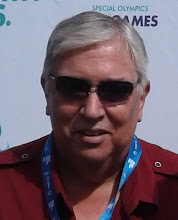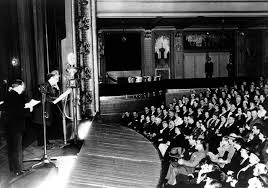It's Only Make Believe: The Way It Was, 3 February
1903---If Mother and Father Block in Los Angeles have any hint that their newborn son, Martin, is destined to become, arguably, America's first superstar disc jockey, it is undetectable for the time being. Nor could they know that he would catch his biggest break, in New York, during one of the most sensationalised kidnap/murder trials in the history of the Republic.
Block began his career reading commercials on a station in Tijuana, Mexico. He later returned to Los Angeles and became a junior assistant at KFWB, where a disc jockey named Al Jarvis hosted a popular local show called Make Believe Ballroom.
Late in 1934, Block was hired by WNEW/New York, where he played music while the station awaited developments in the trial of accused kidnapper Bruno Richard Hauptmann. Block created the illusion that he was broadcasting from a ballroom with the nation’s top dance bands performing live. Block appropriated the name Make Believe Ballroom and the show was an instant hit.Make Believe Ballroom became so popular that when WNEW moved to a new studio on Fifth Avenue, they constructed a simulated ballroom—complete with chandelier and black linoleum—for Block’s broadcasts.---The Radio Hall of Fame, into which Block will be inducted in 1988.
Among other things, Block---whose original Ballroom was popular enough that no less than Glenn Miller cut a recording of a song it inspired, "Make Believe Ballroom Time," that becomes the show's theme---will also be credited for conjuring up one of the most famous slogans in the history of American tobacco and broadcasting: Lucky Strike's longtime LS/MFT (Lucky Strike Means Fine Tobacco) slogan.
Block will host the show until 1954, leaving WNEW for WABC, three years before his second successor will take over the show and make it even more popular and enduring---fellow Radio Hall of Famer William B. Williams.
AIRWAVES . . .
1927: ORDER TO THE CHAOS?---The future Federal Communications Commission is born as the Federal Radio Commission, after President Calvin Coolidge signs into law the Radio Act of 1927
The act is written, according to State University of New York-Otsego professor Fritz Messere, "to bring order to the chaotic situation that developed as a result of the breakdown of earlier wireless acts passed during the formative years of wireless radio communication."
The Act created a five member commission with each member representing a different geographic region of the country. Members' terms overlapped and ran six years. The FRC was given licensing authority for only one year, after which licensing authority was to revert back to the Secretary of Commerce and Labor. The Commission's primary duty was to solve the interference problem which developed after the Radio Act of 1912 became unenforceable.---Messere.The passage of the radio act of 1927 presented a situation without parallel in the history of American executive departments. A wholly new Federal body was called into being to deal with a condition which had become almost hopelessly involved during the months following July 3, 1926, when it had become clear that the Department of Commerce had no authority under the 1912 radio law to allocate frequencies, withhold radio licenses, or regulate power or hours of transmission. The new law itself was, of course, totally untested, and the Federal Radio Commission was called upon to administer it with no clear knowledge as to the limitations which might be created by subsequent court action.---From the first annual report of the Federal Radio Commission.* Equality of transmission facilities, reception, and service as a political goal of Congress.
* The 'Public' at large owned the radio spectrum but individuals could be licensed to use it.
* Because the number of users seeking licenses exceeded the number of channels available some means of determining who should receive a license had to be implemented. The Congress chose criteria based on the "public interest, convenience and/or necessity."
* The broadcaster was responsible for his operation and government should not interfere unless the operator failed to met the public interest standard.
* Although channels were scarce, radio as a form of expression was protected by the First Amendment and the Radio Act of 1927.---The five underlying assumptions underlying the Radio Act of 1927, according to Stay Tuned authors Christopher Sterling and John Kittross.
Intriguingly enough, the Radio Act of 1927 does not mention network broadcasting except in passing, almost: it gave the new FRC the authority to make special regulations applicable to stations engaged in chain broadcasting.
But the Act does provide one of the openings by which, in due course, the so-called Fairness Doctrine would be written and enacted until its original death in the late 1980s: the Act orders radio stations to give equal "opportunity" to political candidates, and gave the FRC powers to levy fines and revoke station licences for violating that and other provisions of the Act.
Over a year after Coolidge signs the act, the FRC will order 164 radio stations, according to Wikipedia, "to justify their existence or be forced to stop broadcasting"---killing 83 stations and leaving most of the survivors with reduced power.
CHANNEL SURFING . . .
VIC & SADE: WALLPAPERING AT MIDNIGHT (NBC, 1941)---Their "adorable landlord's" late visit prompts an unexpected and unusual project. Vic: Art Van Harvey. Rush: Bill Idelson. Sade: Bernadine Flynn. Announcer: Mel Allen. Writer: Paul Rhymer.
THE DANNY KAYE SHOW: BACK FROM WASHINGTON (CBS, 1945)---"Now that you're back," crows Eve (Arden), "we can all get back to abnormal." Famous last words, as the gang discovers when Danny (Kaye) opens the bundle he brought home. Additional cast: Lionel Stander, Ken Niles. Music: Harry James and His Orchestra. Announcer: Ken Niles. Writers: Goodman Ace, Sylvia Fine, Abe Burrows.
THE GREAT GILDERSLEEVE: GILDY THE DIPLOMAT (NBC, 1946)---After Leroy (Walter Tetley) falls out with his best friend and finds himself bored, Gildy (Harold Peary) suggests more of an interest in worldly affairs, among other ideas both may live to regret. Birdie: Lillian Randolph. Marjorie: Lurene Tuttle. Hooker: Earle Ross. Peavey: Richard LeGrand. Writers: John Whedon, Sam Moore.
CONCERTO IN MINIATURE: KICKING BRASS AND TAKING NAMES (NBC/CBC [JOINT], 1953)---That would be Stan Kenton, the master of "Artistry in Rhythm"---and some of the brassiest, voluminous ensemble arranging in jazz (the Kenton band at the height of its life was known particularly as an arrangers' band)---bringing his aggregation to Vancouver, Canada's Georgia Auditorium.
PREMIERING TODAY . . .
1907---Paul Laven (writer: The Bob Hope Show), unknown.
1910---Nelson Case (announcer: Hour of Charm, The New Carnation Contented Hour), Long Beach, California.
1915---Bill Miller (conductor/pianist, The Frank Sinatra Show, The Jim Hawthorne Show), Brooklyn.
1919---Janet Logan (actress: Girl Alone; The Romance of Helen Trent), Eldon, Missouri.
1925---John Fiedler (actor: The Aldrich Family), Platteville, Wisconsin.
1910---Nelson Case (announcer: Hour of Charm, The New Carnation Contented Hour), Long Beach, California.
1915---Bill Miller (conductor/pianist, The Frank Sinatra Show, The Jim Hawthorne Show), Brooklyn.
1919---Janet Logan (actress: Girl Alone; The Romance of Helen Trent), Eldon, Missouri.
1925---John Fiedler (actor: The Aldrich Family), Platteville, Wisconsin.












0 Comments:
Post a Comment
Subscribe to Post Comments [Atom]
<< Home